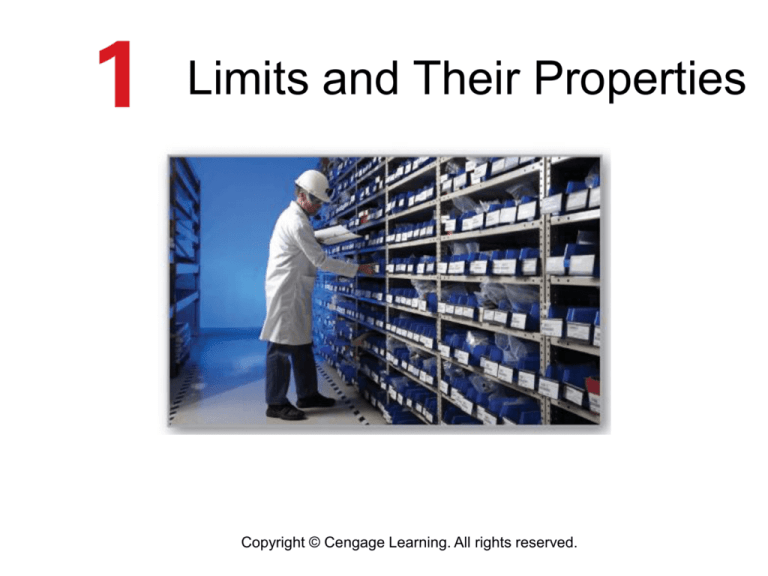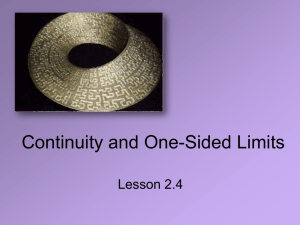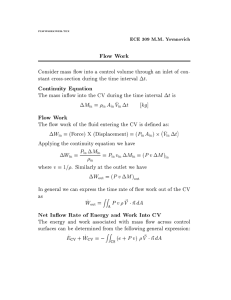
Limits and Their Properties
Copyright © Cengage Learning. All rights reserved.
Continuity and One-Sided
Limits
Copyright © Cengage Learning. All rights reserved.
Objectives
Determine continuity at a point and continuity on an
open interval.
Determine one-sided limits and continuity on a closed
interval.
Use properties of continuity.
Understand and use the Intermediate Value Theorem.
3
Continuity at a Point and on an
Open Interval
4
Continuity at a Point and on an Open Interval
In mathematics, the term continuous has much the same
meaning as it has in everyday usage.
Informally, to say that a function f is continuous at x = c
means that there is no interruption in the graph of f at c.
That is, its graph is unbroken at c and there are no holes,
jumps, or gaps.
5
Continuity at a Point and on an Open Interval
Figure 1.25 identifies three values of x at which the graph of
f is not continuous. At all other points in the interval (a, b),
the graph of f is uninterrupted and continuous.
Figure 1.25
6
Continuity at a Point and on an Open Interval
In Figure 1.25, it appears that continuity at x = c can be
destroyed by any one of the following conditions.
1. The function is not defined at x = c.
2. The limit of f(x) does not exist at x = c.
3. The limit of f(x) exists at x = c, but it is not equal to f(c).
If none of the three conditions above is true, the function f
is called continuous at c, as indicated in the following
important definition.
7
Continuity at a Point and on an Open Interval
8
Continuity at a Point and on an Open Interval
Consider an open interval I that contains a real number c.
If a function f is defined on I (except possibly at c), and f is
not continuous at c, then f is said to have a discontinuity
at c.
Discontinuities fall into two categories: removable and
nonremovable.
A discontinuity at c is called removable if f can be made
continuous by appropriately defining (or redefining f(c)).
9
Continuity at a Point and on an Open Interval
For instance, the functions shown in Figures 1.26(a) and (c)
have removable discontinuities at c and the function shown
in Figure 1.26(b) has a nonremovable discontinuity at c.
Figure 1.26
10
Example 1 – Continuity of a Function
Discuss the continuity of each function.
11
Example 1(a) – Solution
The domain of f is all nonzero real numbers.
From Theorem 1.3, you can conclude that f is continuous at
every x-value in its domain.
At x = 0, f has a nonremovable
discontinuity, as shown in
Figure 1.27(a).
In other words, there is no way to
define f(0) so as to make the function
continuous at x = 0.
Figure 1.27(a)
12
Example 1(b) – Solution
cont’d
The domain of g is all real numbers except x = 1.
From Theorem 1.3, you can conclude that g is continuous
at every x-value in its domain.
At x = 1, the function has a removable
discontinuity, as shown in
Figure 1.27(b).
If g(1) is defined as 2, the
“newly defined” function is
continuous for all real numbers.
Figure 1.27(b)
13
Example 1(c) – Solution
The domain of h is all real numbers. The function h is
continuous on
and
, and, because
h is continuous on the entire real line, as shown in
Figure 1.27(c).
cont’d
,
14
Figure 1.27(c)
Example 1(d) – Solution
cont’d
The domain of y is all real numbers. From Theorem 1.6,
you can conclude that the function is continuous on its
entire domain,
, as shown in Figure 1.27(d).
Figure 1.27(d)
15
One-Sided Limits and Continuity on
a Closed Interval
16
One-Sided Limits and Continuity on a Closed Interval
To understand continuity on a closed interval, you first
need to look at a different type of limit called a one-sided
limit.
For example, the limit from the right (or right-hand limit)
means that x approaches c from values greater than c
[see Figure 1.28(a)].
This limit is denoted as
Figure 1.28(a)
17
One-Sided Limits and Continuity on a Closed Interval
Similarly, the limit from the left (or left-hand limit) means
that x approaches c from values less than c
[see Figure 1.28(b)].
This limit is denoted as
Figure 1.28(b)
18
One-Sided Limits and Continuity on a Closed Interval
One-sided limits are useful in taking limits of functions
involving radicals.
For instance, if n is an even integer,
19
Example 2 – A One-Sided Limit
Find the limit of f(x) =
right.
as x approaches –2 from the
Solution:
As shown in Figure 1.29, the
limit as x approaches –2 from
the right is
Figure 1.29
20
One-Sided Limits and Continuity on a Closed Interval
One-sided limits can be used to investigate the behavior of
step functions.
One common type of step function is the greatest integer
function , defined by
For instance,
and
21
One-Sided Limits and Continuity on a Closed Interval
When the limit from the left is not equal to the limit from the
right, the (two-sided) limit does not exist. The next theorem
makes this more explicit.
22
One-Sided Limits and Continuity on a Closed Interval
The concept of a one-sided limit allows you to extend the
definition of continuity to closed intervals. Basically, a
function is continuous on a closed interval when it is
continuous in the interior of the interval and exhibits
one-sided at the endpoints. This is stated more formally in
the next definition.
23
Figure 1.31
One-Sided Limits and Continuity on a Closed Interval
Figure 1.31
24
Example 4 – Continuity on a Closed Interval
Discuss the continuity of f(x) =
Solution:
The domain of f is the closed interval [–1, 1].
At all points in the open interval (–1, 1), the continuity of f
follows from Theorems 1.4 and 1.5.
25
Example 4 – Solution
cont’d
Moreover, because
and
you can conclude that f is
continuous on the closed interval
[–1, 1], as shown in Figure 1.32.
Figure 1.32
26
Properties of Continuity
27
Properties of Continuity
28
Properties of Continuity
The list below summarizes the functions you have studied
so far that are continuous at every point in their domains.
By combining Theorem 1.11 with this summary, you can
conclude that a wide variety of elementary functions are
continuous at every point in their domains.
29
Example 6 – Applying Properties of Continuity
By Theorem 1.11, it follows that each of the functions below
is continuous at every point in its domain.
30
Properties of Continuity
The next theorem, which is a consequence of Theorem 1.5,
allows you to determine the continuity of composite functions
such as
31
Properties of Continuity
32
Example 7 – Testing for Continuity
Describe the interval(s) on which each function is continuous.
33
Example 7(a) – Solution
The tangent function f(x) = tan x is undefined at
At all other points it is continuous.
34
Example 7(a) – Solution
cont’d
So, f(x) = tan x is continuous on the open intervals
as shown in Figure 1.34(a).
Figure 1.34(a)
35
Example 7(b) – Solution
cont’d
Because y = 1/x is continuous except at x = 0 and the sine
function is continuous for all real values of x, it follows that
y = sin (1/x) is continuous at all real values except x = 0.
At x = 0, the limit of g(x) does
not exist.
So, g is continuous on the intervals
as shown in
Figure 1.34(b).
Figure 1.34(b)
36
Example 7(c) – Solution
cont’d
This function is similar to the function in part (b) except that
the oscillations are damped by the factor x.
Using the Squeeze Theorem, you obtain
and you can conclude that
So, h is continuous on the entire
real line, as shown in Figure 1.34(c).
Figure 1.34(c)
37
The Intermediate Value Theorem
38
The Intermediate Value Theorem
Theorem 1.3 is an important theorem concerning the
behavior of functions that are continuous on a closed
interval.
39
The Intermediate Value Theorem
The Intermediate Value Theorem tells you that at least one
number c exists, but it does not provide a method for finding
c. Such theorems are called existence theorems.
A proof of this theorem is based on a property of real
numbers called completeness.
The Intermediate Value Theorem states that for a continuous
function f, if x takes on all values between a and b, f(x) must
take on all values between f(a) and f(b).
40
The Intermediate Value Theorem
As an example of the application of the Intermediate Value
Theorem, consider a person’s height. A girl is 5 feet tall on
her thirteenth birthday and 5 feet 7 inches tall on her
fourteenth birthday.
Then, for any height h between 5 feet and 5 feet 7 inches,
there must have been a time t when her height was exactly h.
This seems reasonable because human growth is continuous
and a person’s height does not abruptly change from one
value to another.
41
The Intermediate Value Theorem
The Intermediate Value Theorem guarantees the existence
of at least one number c in the closed interval [a, b] .
There may, of course, be more than
one number c such that f(c) = k,
as shown in Figure 1.35.
Figure 1.35
42
The Intermediate Value Theorem
A function that is not continuous does not necessarily
exhibit the intermediate value property.
For example, the graph of the
function shown in Figure 1.36 jumps
over the horizontal line given by y = k,
and for this function there is no value
of c in [a, b] such that f(c) = k.
Figure 1.36
43
The Intermediate Value Theorem
The Intermediate Value Theorem often can be used to
locate the zeros of a function that is continuous on a closed
interval.
Specifically, if f is continuous on [a, b] and f(a) and f(b)
differ in sign, the Intermediate Value Theorem guarantees
the existence of at least one zero of f in the closed interval
[a, b] .
44
Example 8 – An Application of the Intermediate Value Theorem
Use the Intermediate Value Theorem to show that the
polynomial function
has a zero in the
interval [0, 1].
Solution:
Note that f is continuous on the closed interval [0, 1].
Because
it follows that f(0) < 0 and f(1) > 0.
45
Example 8 – Solution
cont’d
You can therefore apply the Intermediate Value Theorem to
conclude that there must be some c in [0, 1] such that
as shown in Figure 1.37.
Figure 1.37
46
The Intermediate Value Theorem
The bisection method for approximating the real zeros of
a continuous function is similar to the method used in
Example 8.
If you know that a zero exists in the closed interval [a, b],
the zero must lie in the interval [a, (a + b)/2] or [(a + b)/2, b].
From the sign of f([a + b]/2), you can determine which
interval contains the zero.
By repeatedly bisecting the interval, you can “close in” on
the zero of the function.
47








